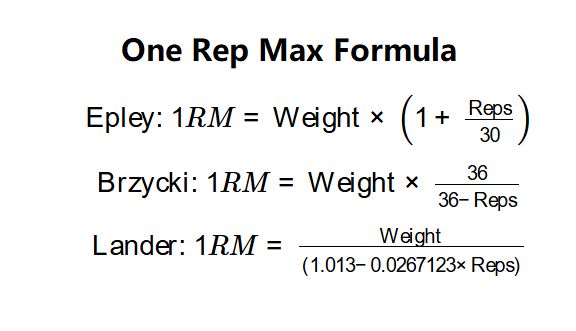1. What is a One-Rep Max Calculator?
Definition: This calculator estimates your one-rep max (1RM) using different formulas (Epley, Brzycki, Lander) based on the weight you lifted and the number of reps, or calculates the weight you should lift for a specific number of reps given a desired 1RM.
Purpose: It helps lifters assess their maximum strength or plan their training by determining appropriate weights for different rep schemes.
2. How Does the Calculator Work?
The calculator uses the following formulas:
\( \text{Epley: } 1RM = \text{Weight} \times \left(1 + \frac{\text{Reps}}{30}\right) \)
\( \text{Brzycki: } 1RM = \text{Weight} \times \frac{36}{36 - \text{Reps}} \)
\( \text{Lander: } 1RM = \frac{\text{Weight}}{(1.013 - 0.0267123 \times \text{Reps})} \)
Where:
- Weight: The weight lifted (in kg or lb, converted to kg).
- Reps: Number of repetitions performed.
Steps:
- Select the calculation mode: One-Rep Max (1RM) or Weight for Specific Reps.
- Enter the Weight Lifted and Number of Reps (for 1RM) or Desired 1RM and Number of Reps (for weight), choosing the unit (kg or lb).
- For "Weight for Reps" mode, select the formula to use (Epley, Brzycki, or Lander).
- Validate inputs to ensure they are positive and reps are within a practical range (1-30).
- Calculate the result using the appropriate formula(s), converting units as needed.
- Display the result(s) to 2 decimal places with the unit dropdown next to it.
3. Importance of One-Rep Max Calculation
Calculating 1RM is crucial for:
- Strength Assessment: Estimates your maximum strength without risking injury by attempting a true 1RM lift.
- Training Planning: Helps you determine appropriate weights for different rep schemes in your workout program.
- Progress Tracking: Allows you to monitor improvements in your lifting performance over time.
4. Using the Calculator
Example 1: Calculate 1RM with 100 kg for 5 reps:
- Weight: 100 kg, Reps: 5
- Epley: \( 100 \times (1 + \frac{5}{30}) \approx 116.67 \, \text{kg} \)
- Brzycki: \( 100 \times \frac{36}{36 - 5} \approx 116.13 \, \text{kg} \)
- Lander: \( \frac{100}{(1.013 - 0.0267123 \times 5)} \approx 115.47 \, \text{kg} \)
- Result in lb: Epley ≈ 257.21 lb, Brzycki ≈ 255.99 lb, Lander ≈ 254.58 lb
Example 2: Calculate weight for 3 reps with a desired 1RM of 200 lb using Epley formula:
- 1RM: 200 lb = 90.72 kg, Reps: 3
- Weight: \( \frac{90.72}{1 + \frac{3}{30}} \approx 82.47 \, \text{kg} \)
- Result in lb: \( 82.47 \times 2.20462 \approx 181.81 \, \text{lb} \)
5. Frequently Asked Questions (FAQ)
Q: What is a one-rep max (1RM)?
A: A one-rep max is the maximum weight you can lift for one repetition with proper form.
Q: Why use multiple formulas?
A: Different formulas (Epley, Brzycki, Lander) provide varying estimates, offering a range to account for individual differences in strength curves.
Q: How accurate are the 1RM estimates?
A: The estimates are generally accurate for most lifters but may vary depending on factors like fatigue, technique, and the number of reps performed.
 Home
Home
 Back
Back
